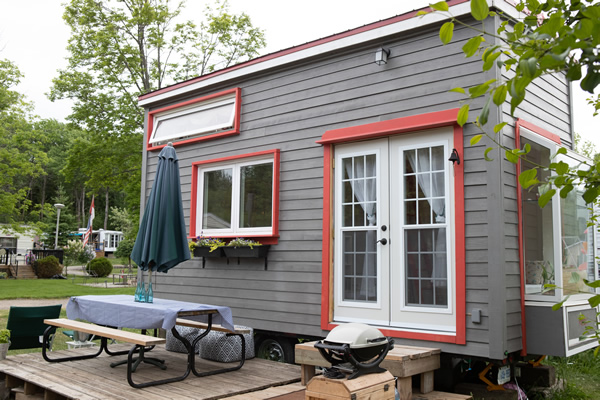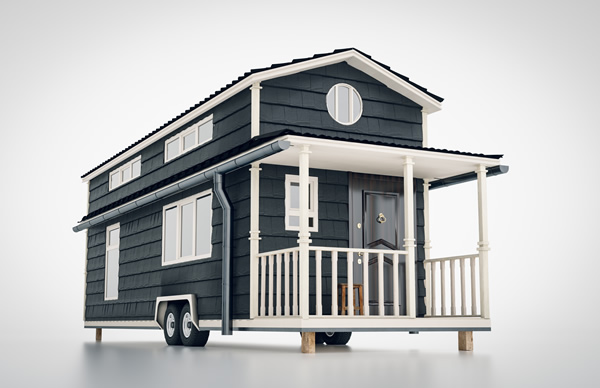Tiny houses are gaining popularity, both for their low cost and the minimalist lifestyle they encourage. As their name implies, tiny houses are typically less than 500 square feet and can be as small as 100 square feet.

The prices of tiny houses vary. It can make a difference if you need to buy land for your tiny house or if you already have the property for it. Are you hiring a contractor to build the house, purchasing a prefabricated house, or are you going to build a tiny house yourself?
The most cost-effective house, which also gives you the ability to customize the home to your specifications, is the one you build yourself. So, join the growing tiny house movements!
Before You Build A Tiny House
While you may be psyched to begin building your new home, make sure that you have all of the requirements and legal permits to build.
Permanent Or Mobile Home?
Are you building on a plot of land or on a trailer bed to make your home mobile? If you’re building on a plot of land, make sure you have the proper certifications and permits and are building to code. Even though you may own the land, there may still be requirements for building on it.
If you build tiny houses on wheels, they may need to conform to RV specifications. Building a tiny house on land gives you flexibility on the shape of the house, while a house on wheels is limited to the footprint of the trailer.
Make A Floor Plan
Because space is at a premium in a tiny house, make sure you have a designed and thought-out floor plan before you begin any work. You want to maximize every square inch to its fullest.
You can purchase tiny home floor plans or design your own. Look into storage ideas and space-saving tips for small spaces. For example, consider a loft bed to get the most use of the room underneath the bed and use storage benches for seating.
Some factors to take into account when making your floor plan:
- Where will the windows be? It’s essential to have windows, as much as you may have the urge to utilize all of the wall space for functionality. Windows let in natural light and make the room seem larger and airier. Design a window for the kitchen and the main room of the house in particular.
- Will you be making a second floor or loft?
- How many sleeping areas / bedrooms do you want to have?
- How much counter space and cabinets do you need in the kitchen? Evaluate what items you’ll be keeping when you move into your tiny home.
- Do you need full-size kitchen appliances, or are you using smaller apartment-size models?
- Do you need a bathtub, or will just a shower do?
- Will you be building a porch?
- If you’re building a tiny mobile home, factor in space for the water tanks. Also, take into account the wheel wells when you design the overall space.
- What about heating and cooling your tiny home? Depending on the climate of where you're building your tiny home, heating and cooling may be crucial factors.
Building Your Tiny House
Once you have your location, floor plan, and legal clearance, you’re ready to build!
- Laying the Foundation
- If you're building a tiny home on land, a solid foundation is crucial. A concrete foundation is not cheap, but if there’s one thing worth splurging on for your home, it should be the foundation. Instead of pouring expensive concrete slab, you can use concrete piers dug into the ground. Put bolts on the piers so that you can then attach the floor to them.
- Installing the Floors
- If you used a concrete pier foundation, attach the floor joists to the bolts in the piers. Lay down boards between the joists to add stability, then install your subflooring. Take extra care to level the floor and confirm that it’s straight. If you install the floor incorrectly, the walls won’t be level, and the whole house will be thrown off. Ensure that the floor is perfectly even before continuing.
- Framing the Walls
- Frame the outer walls according to your floor plan. If you’re building a loft in one area of the house, the walls in that area will be taller. Make sure you're making them the correct heights. Consult your floor plan frequently to avoid having to redo any work. Don’t forget the strategic spots for your air conditioning units. Reconditioned units are a popular choice for tiny houses.
- Building the Exterior
- Build your exterior walls around the framing. If you’re going with siding, you can attach wooden boards for the exterior walls, and then install the siding on top of it. Make sure to leave space for the windows and doors! Consult your floor plan to ensure that you’re not closing up the entrance to the tiny house.
- Adding the Roof
- Shingle and metal roofs are the two most popular types of roofs for tiny houses. As you build the roof, make sure that the slope is even to prevent any water leakage.
- Run the Electricity and Plumbing
- Electricity and plumbing are two areas where you don’t want to make a mistake. If you’re not comfortable with installation or don't have enough experience to handle the electricity and plumbing on your own, consider hiring a professional to, at least, guide you. The money you spend on a plumber may be less than the cost of repairing your flooded home. Make sure the plumbing and electric work is all done to code.
- Building the Interior
- Now, it starts to get exciting! Develop the inside of your tiny house by building your kitchen cabinets, storage, and shelving. You can order cabinets and shelving, but keep in mind that standard kitchen cabinets are often too large and overpowering in a tiny home. Open shelving or glass-fronted cabinets are good options and will not visually overcrowd the room.

In Conclusion
Tiny houses can have significant advantages by saving you money and keeping your life less cluttered and simpler. If you’re thinking of building your own tiny home, it can be a fun and enjoyable project—and one that you’ll reap the rewards from for many years.
